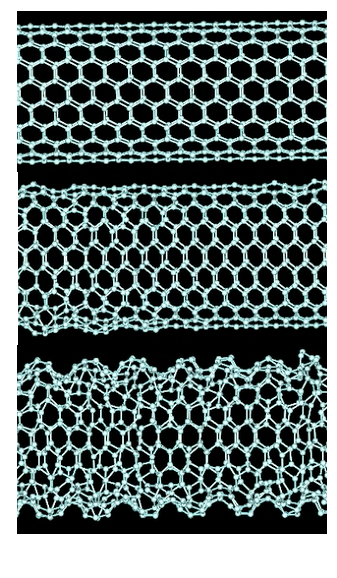
Research Highlights:
Stiffness of single-walled carbon nanotubes under large strain

nanotube under axial compression at 0K.
Ever since the discovery of carbon nanotubes (CNT) by Iijima [1], enormous fundamental and applied research has been in progress. Among them, several experiments and theoretical predictions have revealed the remarkable mechanical properties of CNTs. These mechanical properties may be characterized by the following three features. First, the mechanical properties are highly anisotropic. Second, the Young's modulus (1 TPa) is comparable to that of a diamond. Third, when a CNT that has been bent is released from the strain, it returns to its original form without causing any direct fracture like most materials. These prominent mechanical properties lend themselves to a wide variety of potential applications. It is known that mechanical properties under small strain such as Youngfs modulus are insensitive to helicity. Such helicity independent mechanical properties contrast sharply with those electronic properties that are crucially controlled by helicity. However, the effect of helicity, in other words, the arrangement of six-membered rings, may affect the mechanical properties under such conditions as large strain. To address the issue, we performed large-scale molecular dynamic simulations of the axial deformations in single-walled carbon nanotubes using an O(N) tight-binding method, and found that the buckling morphology largely depends on temperature of CNT [2]. Our simulations indicate that under large strain, 0 K stress is remarkably sensitive to helicity, and that a zigzag nanotube and an armchair nanotube are the stiffest, respectively, under elongation and compression regimes. Furthermore, the elastic properties of a graphite sheet have been investigated using a simple harmonic potential and an analytic bond-order potential. The results suggest that the unique elastic properties of carbon nanotubes originate from those of a six-membered ring.
- gHelical microtubules of graphitic carbonh, S. Iijima, Nature (London) 354, 56 (1991).
- gStiffness of Single-Walled Carbon Nanotubes under Large Strainh, T. Ozaki, Y. Iwasa, and T. Mitani, Phys. Rev. Lett. 84, 1712 (2000).
